by Ana Gotter • May 9, 2017
How to Improve Your Facebook Ad Targeting Using Niche Audiences
Ever see an ad on Facebook and wonder, “Why on earth are they showing this to me?” Guess what? You’ve just been the victim of bad Facebook ad targeting!
While not all Facebook ads are so irrelevant that you want to laugh out loud, most of us rarely click on a Facebook ad. The ad might not be bad, but we’re not really the right audience. Factors like image choice and copy often play a role in our decision to click or scroll away, but ultimately, it’s still a targeting problem.
This is bad news for businesses.
As advertisers, we rely on Facebook Ads to grab our customers’ attention and successfully appeal to a pain point or a need they have. That’s how we get people to click and ultimately convert. But to do that, we have to nail our Facebook ad targeting and ensure that we’re showing the exact right message to the exact right person.
And to do that, you have to segment your Facebook audiences.
Why You Need to Segment Your Audiences
No matter what business you’re in, there will almost always be several niches within your audience. You may have different groups of customers who use your product in different ways.
Some people, for example, only use their Fitbit to track their steps, others use it to track their heart rate and sleep patterns. Not all Fitbits track all of this data, which means different people will be interested in different Fitbits.
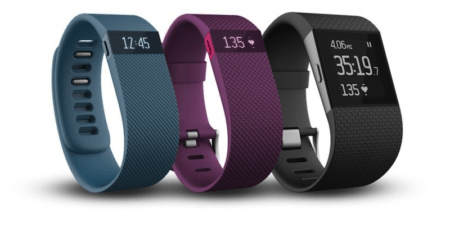
For example, a basic Fitbit can track steps alone, while a more expensive version is needed to track sleep and heart rate. If you only care about tracking steps, you probably only want the basic model. If you want to track your sleep patterns, you need a higher-end Fitbit.
As a result, Fitbit has at least two audience niches (probably a lot more, but we’ll stick with these two for this example): 1) people who want to be more active and 2) people who are concerned about the details of their health.
Would it make sense for Fitbit to run a Facebook ad targeting people who want to be more active with an ad talking about tracking sleep patterns? Not really. However, an ad talking about how easy it is to track and increase your activity levels with Fitbit would probably get a pretty good response.
This is why targeting the right niche audience is so important. The better your Facebook ad targeting is, the more relevant your ads will be. And, since ads with a relevance score of 8 have a 77% higher CTR than those with a relevance score of 3, better niche targeting means better results from your campaigns!
Improving Your Facebook Ad Targeting
There are a number of different ways you can refine your Facebook audiences into distinguishable segments. You can target these niche groups individually, through a combination of custom audiences and additional targeting options.
Buyer Personas
Buyer personas are a great tool you can use to identify niches in your market. A well-researched buyer persona will tell you a lot about the who, what and why that motivates your potential customers.
For example, let’s say you’re trying to sell vacuums. You could target new parents with ads that show a frazzled mom trying to clean up a million tiny Cheerios stomped into the carpet, and have copy reminding them that your powerful vacuum has a special carpet setting. Meanwhile, you could run an ad targeting dog owners focusing on the pet hair that gets everywhere.
Eco Flower does a great job of using their buyer personas to create specific ads for specific needs:
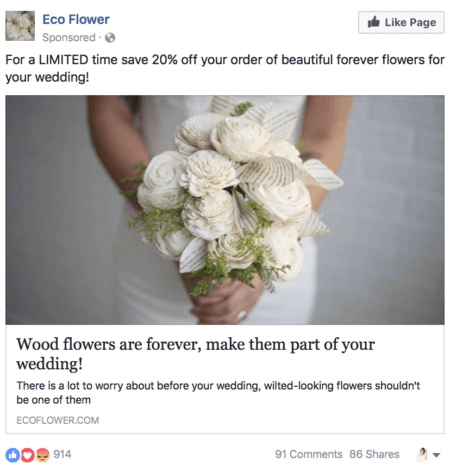
Eco Flower has a variety of products, and has targeted the specific buyer persona of brides in this ad.
You can use specific Facebook ad targeting for specific groups of users. B2C businesses can target users based on lifestyle and behavioral traits. B2B businesses can target users based on things like education, job title, and industry to connect with users that fit into their buyer persona.
How They Use Your Product
As we mentioned in the previous section, there are almost always differences in how specific people use your product and which products they prefer.
A marketing agency, for example, may have clients that only want consulting, only want analytics, or only want ad copy. However, some potential customers might want all three. Restaurants with bars have people who only come in for drinks and appetizers, and a clothing tailor may work on someone’s jeans one minute and a wedding dress the next.
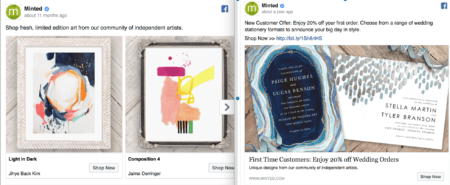
Minted has ads that highlight different products and product use cases.
One of the best ways to do this is through Facebook’s lookalike audiences. You can create lookalike audiences off of any saved custom audience, including those who have purchased from you or have visited your site.
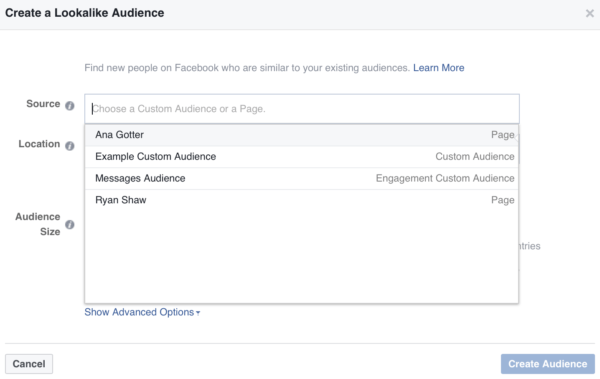
You can create lookalike audiences from any saved audience.
By incorporating elements of the ads that worked best for each audience segment into their lookalike audience—like an offer, copy, or image—you can have better luck grabbing their attention the first time around.
Past Purchase History
I was a salesperson at Kay Jewelers for several years, and I made sure to remember my customers’ purchase history. Why? Because it helped me predict what their interests would be in the future.
Someone who bought an engagement ring would almost certainly want a matching band and a ring for their soon-to-be spouse. If I kept track of what they bought and showed an interest in during the first sale, not only did I have great recommendations to show them when they came back in, but I could also call them and let them know the pieces were there and that a sale was coming up soon.
Similarly, past purchase history tells you a lot about what your customers will purchase from you in the future. It tells you what complementary products they may need. For example, if someone buys an iPhone, you know they’ll need a charger, a case, and a screen protector.
In this ad, Camtasia uses purchase history to try and upsell their existing customers:
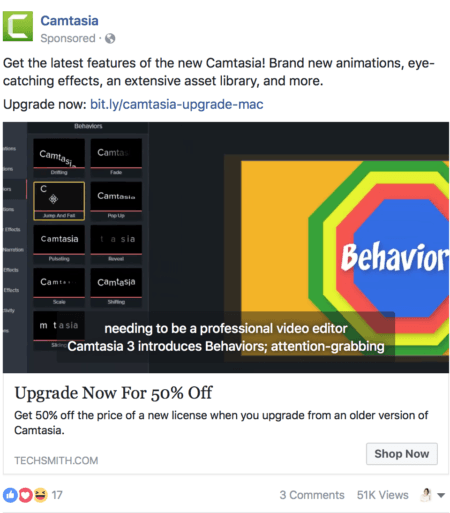
This ad used retargeting to loyal customers who had purchased the software in the past, upselling new features based on their stage in the sales funnel.
Purchase history also tells you what price range they may way to stay in, which is just as important. A small business that can only afford a $100-a-month invoicing software won’t even click on the ad if you show them the $800 enterprise plan with all the bells and whistles.
To make the most of your purchase history data, try combining segments of users who have purchased the same or similar products into distinct custom audience groups and use ads to show them recommendations of complementary products or services in a similar price range. You can go for a slight upsell, but keep it within reason.
Visits to Specific Pages on Your Site
This is one of the easiest and fastest ways to segment your audience. By building custom audiences created based on website visits, you can show highly relevant ads to users who have visited specific pages on your site.
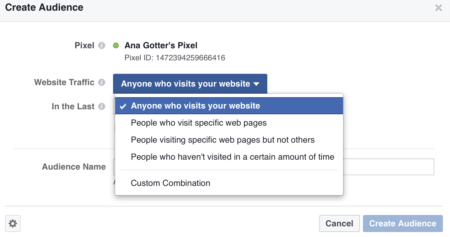
You can retarget site visitors who have visited specific pages on your site.
This works particularly well when you target users who have abandoned their cart after adding something to it. It means they were seriously considering it and they got cold feet (or distracted) at the last minute. One little push from a Facebook ad could be all they need, especially if you address common objections in your ad copy.
To target users who have visited specific pages, create a custom audiences from users who visited your website. In my experience, this is most effective if you’re retargeting users within 15 days of when they visited your. If you wait longer than 30 days, this tactic becomes at least 10% less effective.
Stage of the Digital Sales Funnel
If a customer walked into a brick and mortar store for the first time, the store owner would almost certainly greet them differently than someone who had been a customer for 10 years.
With a long-term customer, the owner might say, “Hey, how’s the wife? By the way, you have to see what I just got in? I thought of you right away…your wife will love this!”
Saying that to a first-time customer, however, probably wouldn’t go over very well…
This same principle applies to your Facebook ad targeting. Most of the time, when you’re running ads on Facebook, you don’t know the names and histories of everyone you’re marketing to, but you do know something important about them: where they are in your sales funnel.
Any good sales funnel has 5 stages: awareness, consideration, purchase, loyalty, and advocacy. By segmenting your Facebook audiences by the stage of the sales funnel they’re in, you can create ads that match the needs of your potential customers. A well-timed offer of a discount to someone in the consideration stage, for example, could be the last push they need to convert.
Here’s a Facebook ad MM.LaFleur uses to target potential customers in the awareness phase of their sales funnel:
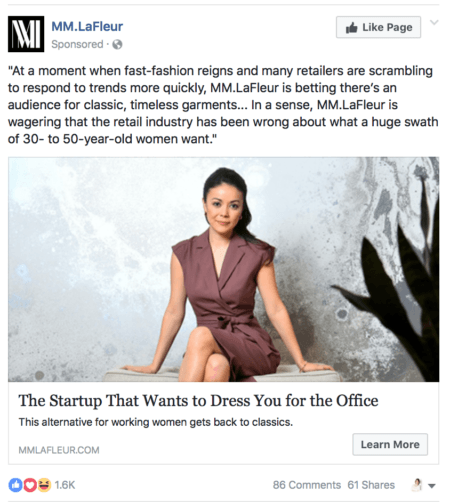
This ad is perfect for cold traffic, clearly summing up why users have need for this specific service.
The best targeting options for the five stages of the funnel are:
- Awareness: cold traffic using interest targeting and/or lookalike audiences
- Consideration: retargeting custom audiences of users who have visited your site or engaged with your ads but haven’t converted
- Purchase: retargeting custom audiences of site visitors
- Loyalty: retargeting custom audiences of repeat customers
- Advocacy: retargeting your most high value customers
As we’ve discussed throughout this article, the most effective Facebook ad targeting uses what you know about your customers in each stage of your funnel to deliver the right messaging…to the right person…at the right time.
Conclusion
Whether you’re trying to increase video views, generate leads, or drive sales, audience segmentation is the key to effective Facebook ad targeting. The better you know your audience, the better suited your ads will be to their pain points and potential objections.
After all, do you really want people to see your ad and think, “Why on earth are they showing this to me?”
What do you think? How do you refine your audiences for better Facebook ad targeting? Which audience segmentation tactics do you use?




